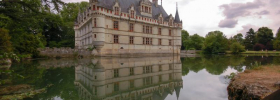 Home
Home- > Monuments France
- > Ile-de-France
- > Yvelines
- > Chevreuse
- > Château de la madeleine
Château de la Madeleine
Its construction began between 1030 and 1090. It was commissioned by Gui I, Seigneur de Chevreuse. They were defending the town of Chevreuse, a victim of looting. From that time that remains likely that the dungeon. In the eleventh century, the tower was probably surrounded only by a wooden fence that was replaced by stone walls at the twelfth century. A century later, probably during the reign of Anseau Chevreuse, significant changes were made to the castle, including the construction of battlements. The door was protected by a moat where the water was retained by a dam and was probably used for domestic purposes. Drawbridges allow vehicular traffic and pedestrians.
In 1356, the castle changed hands: Ingerger the Great Lord of Chevreuse and Amboise, was taken prisoner in England during the Hundred Years War. He is forced to sell his estate to pay his ransom. The future Pierre de Chevreuse bought it. The existing fortifications were greatly improved under the reigns of Charles V and Charles VI, who fund the work through the royal taxes. The work completed under Louis XI (1461-1483). Like the castle, the town was also fortified: you build a wall embattled high of 3.50 meters and equipped with turrets. Defenses are complemented by a moat of 15 meters.
In the seventeenth century, around 1661, John Smith oversaw changes to the tower and the road from the abbey of Port-Royal-des-Champs to downtown Chevreuse through the Château de la Madeleine was baptized its name. It seems that the tower was partially restored in the nineteenth century. The latest changes are from the twentieth century. At the heart of the castle was built home of the regional park of the upper valley of Chevreuse, whose modern architecture blends in surprisingly well in the courtyard while using the old rooms.
Accommodation nearby
Latest news onChâteau de la Madeleine
Opening hours
-Open Wednesday to Saturday from 2:00 p.m to 5:30 p.m.
-Open on Sundays and holidays from March to October from 10:00 a.m to 16:00 p.m.
-Open on Sundays and holidays from November to February from 2:00 p.m to 5:30 p.m.
Prices
Individual price: 2.50 €.
Tourism near
 Visit the city of Chevreuse
Visit the city of Chevreuse - 20 Museum
- 24 Monuments
Tours
 Chevreuse
Chevreuse
 Le Mesnil-Saint-Denis
Le Mesnil-Saint-Denis
 Welcome to Orsay
Welcome to Orsay


































